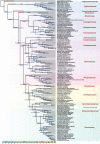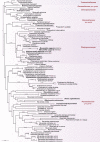A higher-rank classification for rust fungi, with notes on genera
- PMID: 34124616
- PMCID: PMC8165960
- DOI: 10.3114/fuse.2021.07.02
A higher-rank classification for rust fungi, with notes on genera
Abstract
The rust fungi (Pucciniales) with 7000+ species comprise one of the largest orders of Fungi, and one for which taxonomy at all ranks remains problematic. Here we provide a taxonomic framework, based on 16 years of sampling that includes ca. 80 % of accepted genera including type species wherever possible, and three DNA loci used to resolve the deeper nodes of the rust fungus tree of life. Pucciniales are comprised of seven suborders - Araucariomycetineae subord. nov., Melampsorineae, Mikronegeriineae, Raveneliineae subord. nov., Rogerpetersoniineae subord. nov., Skierkineae subord. nov., and Uredinineae - and 18 families - Araucariomycetaceae fam. nov., Coleosporiaceae, Crossopsoraceae fam. nov., Gymnosporangiaceae, Melampsoraceae, Milesinaceae fam. nov., Ochropsoraceae fam. & stat. nov., Phakopsoraceae, Phragmidiaceae, Pileolariaceae, Pucciniaceae, Pucciniastraceae, Raveneliaceae, Rogerpetersoniaceae fam. nov., Skierkaceae fam. & stat. nov., Sphaerophragmiaceae, Tranzscheliaceae fam. & stat. nov., and Zaghouaniaceae. The new genera Araucariomyces (for Aecidium fragiforme and Ae. balansae), Neoolivea (for Olivea tectonae), Rogerpetersonia (for Caeoma torreyae), and Rossmanomyces (for Chrysomyxa monesis, Ch. pryrolae, and Ch. ramischiae) are proposed. Twenty-one new combinations and one new name are introduced for: Angiopsora apoda, Angiopsora chusqueae, Angiopsora paspalicola, Araucariomyces balansae, Araucariomyces fragiformis, Cephalotelium evansii, Cephalotelium neocaledoniense, Cephalotelium xanthophloeae, Ceropsora weirii, Gymnotelium speciosum, Lipocystis acaciae-pennatulae, Neoolivea tectonae, Neophysopella kraunhiae, Phakopsora pipturi, Rogerpetersonia torreyae, Rossmanomyces monesis, Rossmanomyces pryrolae, Rossmanomyces ramischiae, Thekopsora americana, Thekopsora potentillae, Thekopsora pseudoagrimoniae, and Zaghouania notelaeae. Higher ranks are newly defined with consideration of morphology, host range and life cycle. Finally, we discuss the evolutionary and diversification trends within Pucciniales. Citation: Aime MC, McTaggart AR (2020). A higher-rank classification for rust fungi, with notes on genera. Fungal Systematics and Evolution 7: 21-47. doi: 10.3114/fuse.2021.07.02.
Keywords: 37 new taxa; Uredinales; Urediniomycetes; host alternation; life cycles.
© 2021 Westerdijk Fungal Biodiversity Institute.
Figures




References
-
- Aime MC. (2006). Toward resolving family-level relationships in rust fungi (Uredinales). Mycoscience 47: 112–122.
-
- Aime MC, Matheny PB, Henk DA, et al. . (2006). An overview of the higher-level classification of Pucciniomycotina based on combined analyses of nuclear large and small subunit rDNA sequences. Mycologia 98: 896–905. - PubMed
-
- Aime MC, McTaggart AR, Mondo SJ, et al. . (2017). Phylogenetics and phylogenomics of rust fungi. Advances in Genetics 100: 267–307. - PubMed
LinkOut - more resources
Full Text Sources
Research Materials
